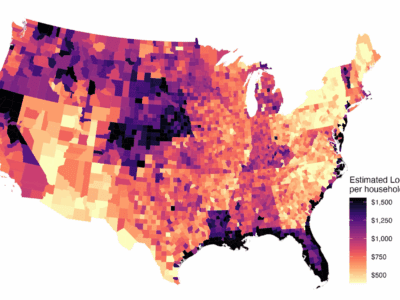Last Year’s Climate Bond May Not Be What You Thought
While investing in important adaptation and resilience measures, Proposition 4 does less to create new clean energy infrastructure investments
Last year, legislators passed, the governor signed, and California voters approved, a ten billion dollar climate bond (the Safe Drinking Water, Wildfire Prevention, Drought Preparedness, and Clean Air Bond Act of 2024, SB 867 (Allen), which appeared on the November ballot as Proposition 4). While the bond act’s full title largely tells the story of its contents, the water- and resilience-focused spending may not be what all Californians expected from the state’s first self-proclaimed climate bond.
In January, the Governor put out his plan for Climate Bond Implementation, which proposed that approximately 27% of total Bond funds be allocated and distributed in 2025-2026. The Legislature may decide to change the Governor’s proposal—for example, to institute multi-year spending plans (per the Legislative Analyst’s Office recommendation) or to pull back on the Governor’s proposed funding shifts in the May budget revision (such as the proposal to move $300 million in climate-related project costs from the General Fund to the Proposition 4 climate bond). Of course, the state’s fiscal outlook and this year’s budget negotiations have added extra complications to bond decisions.
The negotiations will continue to unfold, but in the meantime, it is helpful to look at the contents of the bond’s legislative language. Some may be surprised to learn, for example, that the bond primarily addresses climate adaptation and resilience, rather than climate mitigation such as clean energy infrastructure. This post outlines some major areas, projects, and funding within the language passed in 2024.
The bond distributes funding for numerous priorities including:
-
- Safe drinking water, drought, flood, and water resilience ($3.8 billion);
- Wildfire and forest resilience ($1.5 billion);
- Coastal resilience ($1.2 billion);
- Extreme heat mitigation ($450 million);
- Biodiversity and nature-based climate solutions ($1.2 billion);
- Climate-smart, sustainable, and resilient farms, ranches, and working lands ($300 million)
- Park creation and outdoor access ($700 million); and
- Clean air programs ($850 million)
Looking at the bond’s legislative language, the California Natural Resources Agency and its departments, boards, commissions, and conservancies, appear to have the most responsibility for bond implementation, although the Governor’s Office of Emergency Services, the Office of Planning and Research (now the Governor’s Office of Land Use and Climate Innovation (LCI)), the California Energy Commission, and other agencies will also play a role.
Given that the climate bond will be a source of funding for California climate projects in the near future, especially in the absence of federal grants and loans, it behooves advocates and communities to be aware of the equity aspects and the energy and transmission components built into the bond, especially as some may have expected more climate mitigation measures. The next two subsections outline the bond’s provisions in these two categories.
Equity
The Bond includes a strong focus on equity. The most comprehensive equity provision, for example, stipulates that no less than 40% of total available bond funds must be distributed to projects that “provide meaningful and direct benefits to vulnerable populations or disadvantaged communities” and a minimum of 10% of total available bond funds must be distributed to projects that “provide meaningful and direct benefits to severely disadvantaged communities.” (§ 90140). The bill language defines key terms as follows:
-
- “Disadvantaged community” is defined as “a community with a median household income of less than 80 percent of the area average or less than 80 percent of statewide median household income.” (§ 90100 (d)).
- “Severely disadvantaged community” is defined as a “community with a median household income of less than 60 percent of the area average or less than 60 percent of statewide median household income.” (§ 90100 (j)).
- “Vulnerable population” is defined as “a subgroup of population within a region or community that faces a disproportionately heightened risk or increased sensitivity to impacts of climate change and that lacks adequate resources to cope with, adapt to, or recover from such impacts.” (§ 90100 (o)).
The bond legislative language also includes provisions for technical assistance, allowing up to 10% of all climate bond funds to be designated for “multidisciplinary” technical assistance (TA) to disadvantaged communities, severely disadvantaged communities, or vulnerable population. (§§ 90600 (b)(1), (b)(2)). If a state agency awarding funds deems it necessary, more than 10% can be allocated towards TA.
In addition to this general provision, additional equity language can be found in specific chapters of the legislative bond language. For example, the section on groundwater storage, recharge, and other groundwater projects mandates that at least $25 million be allocated to projects that “provide direct benefits to tribal communities.” (§ 91012. (a)). The Parks chapter contains language specifying that $200 million shall be deployed for projects in disadvantaged communities, including those that expand access to the state park system for disadvantaged communities, those that enhance coastal access for disadvantaged communities, and those that build recreational infrastructure in communities where investment has historically been lacking. (§ 94020 (e-g)).
Energy-related infrastructure funding
Funding in the 2024 climate bond legislation for energy and transmission includes money for:
-
- The California Energy Commission’s (CEC) Long-Duration Energy Storage Program ($50 million) (§ 94530). This program invests in the demonstration and deployment of storage solutions with long-term energy-duration capabilities in order to strengthen grid reliability.
- Grid resilience projects that benefit disadvantaged communities, severely disadvantaged communities, or vulnerable populations, including microgrids ($135 million from wildfire resilience bond monies) (§ 91510 (a)).
- Projects that publicly finance transmission infrastructure, which are needed to meet the state’s clean energy goals or reduce ratepayer costs ($325 million) (§ 94520). The administering agencies can, but do not have to, prioritize multi-benefit projects that reduce wildfire risk, reduce dependence on fossil fuel plants in disadvantaged communities, and promote technologies that alleviate stress on electricity rates. (§ 94520(b)).
- Projects to improve port facilities and projects to construct public port facilities where wind turbines can be built and stored, as well as the expansion of public port facilities that can accommodate offshore wind related vessels ($475 million) (§94540). The bill also requires the CEC to “prioritize projects that can show matching funds or that are located at staging and integration ports that have released a notice of preparation pursuant to the California Environmental Quality Act process on or before February 29, 2024.” (§94540(c)). The two ports that meet these criteria are the Ports of Long Beach and Humboldt. (Note, however, that the Governor’s May budget proposal takes $42.8 million for offshore wind infrastructure out of the General Fund and shifts it to Proposition 4, resulting in less overall funding for offshore wind infrastructure).
Taken together, the expenditures in the climate bond represent a significant commitment to climate resilience and adaptation efforts, especially for disadvantaged communities and vulnerable populations. The bond does not, however, greatly increase funding for clean energy infrastructure (although it may leverage private investment). Some energy experts have called for another bond to fund climate mitigation measures and create a state version of the Inflation Reduction Act—however, given that California voters just passed a climate bond in 2024 and the state is now facing a serious budget deficit, it seems unlikely that such an effort is in California’s immediate future.







Reader Comments